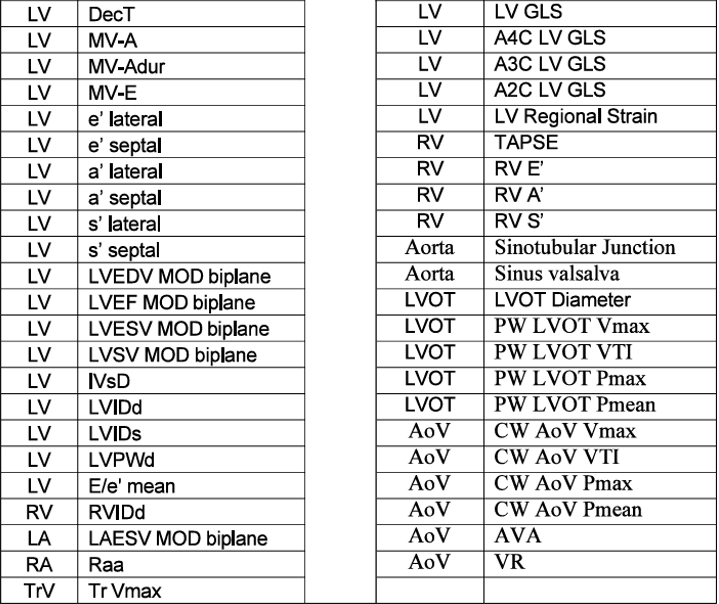Us2.ai receives FDA clearance for Us2.v2, transforming cardiovascular ultrasound analysis
Singapore – April 5, 2024 — Us2.ai, a leading MedTech firm backed by prominent investors including IHH Healthcare, Heal Partners, Peak XV Partners (formerly Sequoia India) and EDBI announces FDA clearance for Us2.v2, featuring 45 automated echo parameters, including strain analysis [1], marking a significant stride in medical innovation.
Us2.v2 is an advanced image post-processing analysis software device designed to aid diagnostic review, analysis and reporting of echocardiographic DICOM images. Us2.v2 automatically generates clinically relevant and reproducible quantitative echocardiographic measurements [2], reducing analysis time. By streamlining the echocardiographic workflow, clinicians can generate and edit reports faster, with precision, and keep complete control.
Building upon the success of its previous FDA-cleared and CE marked solution, Us2.v1, which revolutionized automated clinical workflow for cardiac measurements, key highlights of Us2.v2 and related publications include:
- Strain imaging – automated GLS quantification e.g. as applied in the detection of heart failure [3]
- Regional strain – e.g. as applied in the detection of coronary artery disease [3]
- Aortic stenosis measurements (referencing ASE recommendations [4])
- Comprehensive quantitative analysis of cardiac structure and function including left/right atrial and ventricular linear dimensions, volumes, systolic, and diastolic function
- Essential measurements used in current guidelines for the detection of conditions such as cardiac amyloidosis and heart failure with preserved ejection fraction [5-6-7]
Key benefits include:
- Real-time fully automated image processing & analyses, with less variability compared to human measurement
- Explainable AI output, allowing users to evaluate all automated annotations & measurements
- Streamlined reporting – automated generation of comprehensive reports
- Guidelines references [8]
- Decision support tools for qualified sonographers/reviewing physicians to perform edits/revise markup on echocardiographic image measurements
“FDA clearance of Us2.v2 marks a significant milestone and reinforces our commitment to advancing cardiovascular care through innovative technology,” said James Hare , CEO and co-founder of Us2.ai.
“These additions are critical for busy clinical practices looking towards detection of CV diseases such as aortic stenosis, HFpEF and amyloidosis to provide better and more precise care for patients,” said Justin Ezekowitz, MD, Canadian VIGOUR Centre, Faculty of Medicine and Dentistry, University of Alberta, Canada. “Automation in echo will allow more patients to take advantage of new advances in targeted therapy and reduce the uncertainty in measurement.”
“By offering advanced capabilities that significantly enhance both precision and efficiency of echocardiographic analysis, this innovation dramatically reduces analysis time thereby speeding up clinical workflow. This is particularly helpful in clinical states that require additional imaging parameters such as strain; or are challenged by variability in interpretation such as aortic stenosis. Additionally, it also ensures high-quality patient care with the integration of international guidelines that aligns with the latest clinical standards,” said Madhav Swaminathan, MD, Associate Professor of Anesthesiology at Duke Medical Center.
Us2.v2 is intended for use in adult patients and aims to support qualified cardiologists, sonographers, or other licensed healthcare practitioners in clinical decision-making processes. For more information about Us2.v2 and its impact on cardiovascular ultrasound analysis, please visit www.Us2.ai.
end of release.
References
[1]

[2] Tromp, J., Bauer, D., Claggett, B. L., Frost, M., Iversen, M. B., Prasad, N., Petrie, M. C., Larson, M. G., Ezekowitz, J. A., & Solomon, S. D. (2022). A formal validation of a deep learning-based automated workflow for the interpretation of the echocardiogram. Nature communications, 13(1), 6776. https://doi.org/10.1038/s41467-022-34245-1
[3] Myhre, P. L., Hung, C., Frost, M., Jiang, Z., Ouwerkerk, W., Teramoto, K., Svedlund, S., Saraste, A., Hage, C., Tan, R. S., Beussink‐Nelson, L., Fermér, M. L., Gan, L., Hummel, Y. M., Lund, L. H., Shah, S. J., Lam, C. S., & Tromp, J. (2023). External validation of a deep learning algorithm for automated echocardiographic strain measurements. European Heart Journal, 5(1), 60-68. https://doi.org/10.1093/ehjdh/ztad072
[4] Krishna, H., Desai, K., Slostad, B., Bhayani, S., Arnold, J. H., Ouwerkerk, W., Hummel, Y., Lam, C. S. P., Ezekowitz, J., Frost, M., Jiang, Z., Equilbec, C., Twing, A., Pellikka, P. A., Frazin, L., & Kansal, M. (2023). Fully Automated Artificial Intelligence Assessment of Aortic Stenosis by Echocardiography. Journal of the American Society of Echocardiography : official publication of the American Society of Echocardiography, 36(7), 769–777. https://doi.org/10.1016/j.echo.2023.03.008
[5] Cotella, J. I., Randazzo, M., Maurer, M. S., Helmke, S., Scherrer‐Crosbie, M., Soltani, M., Goyal, A., Zaręba, K. M., Cheng, R. K., Kirkpatrick, J. N., Yogeswaran, V., Kitano, T., Takeuchi, M., Fernandes, F., Hotta, V. T., Vieira, M. L. C., Elissamburu, P., Ronderos, R., Prado, A., . . . Lang, R. M. (2024). Limitations of apical sparing pattern in cardiac amyloidosis: a multicentre echocardiographic study. European Heart Journal. Cardiovascular Imaging. https://doi.org/10.1093/ehjci/jeae021
[6] Ioannou, A., Patel, R. K., Razvi, Y., Hanger, M., Martinez‐Naharro, A., Venneri, L., Lim, H. S., Yoran, H., Frost, M. W., Lam, C. S., Gillmore, J. D., & Fontana, M. (2023). Automated analysis of echocardiograms at diagnosis is able to predict prognosis in ATTR cardiomyopathy. European Heart Journal. Cardiovascular Imaging, 24(Supplement_1). https://doi.org/10.1093/ehjci/jead119.387
[7] Tromp, J., Seekings, P. J., Hung, C. L., Iversen, M. B., Frost, M. J., Ouwerkerk, W., Jiang, Z., Eisenhaber, F., Goh, R. S. M., Zhao, H., Huang, W., Ling, L. H., Sim, D., Cozzone, P., Richards, A. M., Lee, H. K., Solomon, S. D., Lam, C. S. P., & Ezekowitz, J. A. (2022). Automated interpretation of systolic and diastolic function on the echocardiogram: a multicohort study. The Lancet. Digital health, 4(1), e46–e54. https://doi.org/10.1016/S2589-7500(21)00235-1
[8]
Heart Failure with Preserved Ejection Fraction (HFpEF)
Heart Failure with mildly reduced Ejection Fraction (HFmrEF)
Heart Failure with reduced Ejection Fraction (HFrEF)
Aortic Stenosis
Mitral Regurgitation
Tricuspid Regurgitation
Pulmonary Hypertension
Hypertrophic Cardiomyopathy
Cardiac Amyloidosis


